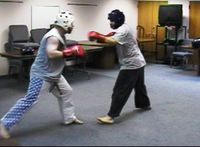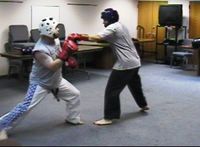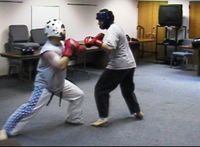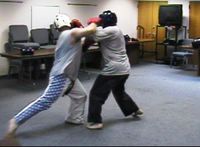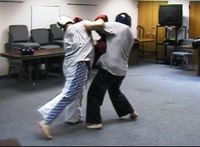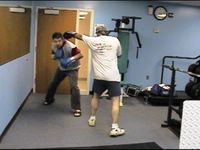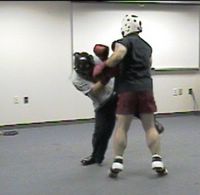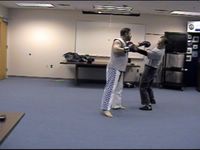TDA Training
Tuesday, February 08, 2005
Training Diary 2/5/05
Participants: Sam, Nathan, Mike
Sam and I drilled the parry of the jab:
· Remember that when you parry the jab, you should move in the direction that the parry leads you. In other words, if you parry a punch to the inside, move to the outside. So against a left jab, parry and step to the right.
· If you are going to parry and counter, you may sometimes have to step back versus a taller fighter.
· Remember not to parry the jab across your lead arm, thereby trapping yourself. It will leave you open to a 1-2.
· Pat or slap the punch so that it moves just outside of the target. In other words, make the left jab miss to the left of your head or shoulder.
· Sam observed that you should never reach out for the punch.
· Never parry the punch into your other weapon.
We then drilled blocking the jab:
· This should be used when you can't do anything else, or when you're setting up a counter by trying to establish a pattern. It can also be used when covering up, a last-resort tactic.
· When you do this, leave the lead free to counter. Don't use both hands unless the lead-off fighter is in close range.
· Mike observed that Nathan was leaning back. Don't do that.
· Remember to stay sideways so that there's not a squared-off body to hit.
· Sam was mixing this with the catch, which is a block, followed by redirecting the punch downward.
Then we slipped and countered the jab:
· Again, remember to pivot out of the slip and thereby bring both hands to bear on the opponent.
· Sam did very well on this and needs to try to integrate it more into sparring. It will become an effective defense.
· If you're shorter than your opponent, you need to step in as you slip, in order to be able to counter.
We then worked on rolling the straight right hand:
· By popping the punch, or using a snappy redirection, it prevents the #3 (lead hook) from being able to connect with power.
· Work the roll, then counter with a lead hook. It's easy to close if you roll properly.
· Sam reminds us to bring the lead back into position quickly.
· After rolling, make sure the rear hand is high to guard the lead hook (especially if you miss the deflection).
· Remember to keep the lead hand aimed at the opponent while rolling the punch.
· Another counter to try is the lead backfist.
Specific advice for Mike:
When leading, you're getting in range without punching. Don't fake so much or it's predictable and can be ignored by your opponent. Always have a plan if you're in range.
Continue to work on being looser. If you're so tight, you'll get tired fast.
Circle away from the power-hand. For example, against an opponent who's right-handed, circle primarily to your right.
Us 1-1-2 and 1--1-2
Specific advice for Nathan:
Needs to work on slipping to the inside and using the right counter more.
Work on rolling the right more.
Simultaneous counters.
Practice more versus untrained and multiple opponents
Work the double-hook. It works almost every time.
Coach more. Pull Mr. Sam & Mike aside and give them specific coaching more often,
Specific advice for Sam:
Work on rolling the right hand.
Torque your hips when punching for more power.
Remember not to lead off, throw your combination, then stop in front of the opponent-CLEAR!
Footwork, intention & timing!
Don't walk, step & slide
Never use the lead hand for defense, except against the opponent's right. Always use the rear-hand to parry, stop or check the opponent's lead.
Us 1-1-2 and 1--1-2
Always double or triple jab to lead effectively.

